Our Research
We are studying High Energy Astrophysics, especially, Gamma-Ray Bursts (GRBs). GRBs are the most powerful explosion in the universe, and their explosion mechanism is still unknown. It is believed that dynamics of catastrophic, gravitational collapse of massive stars at the end of their stellar evolution has to be investigated to understand the central engine of GRBs. The dynamics will be related with the formation of a black hole or magnetar at the center of the massive stars and/or coalescence of binary neutron stars. We are planning to understand the extreme phenomena using advanced physics such as general relativity and particle physics. In some cases, we perform numerical simulations with super-computers to understand the GRB dynamics.
GRBs are considered as promising candidates as sources of high energy cosmic rays. In fact,most energetic cosmic rays, that is, Ultra High Energy Cosmic Rays (UHECRs) may be generated in GRBs. It is pointed out that UHECRs may interact with surrounding material, which results in emitting high energy gamma-rays and neutrinos. We are interested in particle acceleration in GRBs and resulting gamma-rays and neutrinos. We are estimating flux of such high-energy particles at the earth, and checking whether such signals can be detected by current detectors such as Auger, HESS, AMANDA-II, or by future detectors such as GLAST and IceCube.
Also, it is considered that GRBs are related with supernova explosion and neutron stars. So, we are studying high energy phenomena of supernovae and neutron stars. We would like to show you some topics of our research below.
0. About Scales
|
|
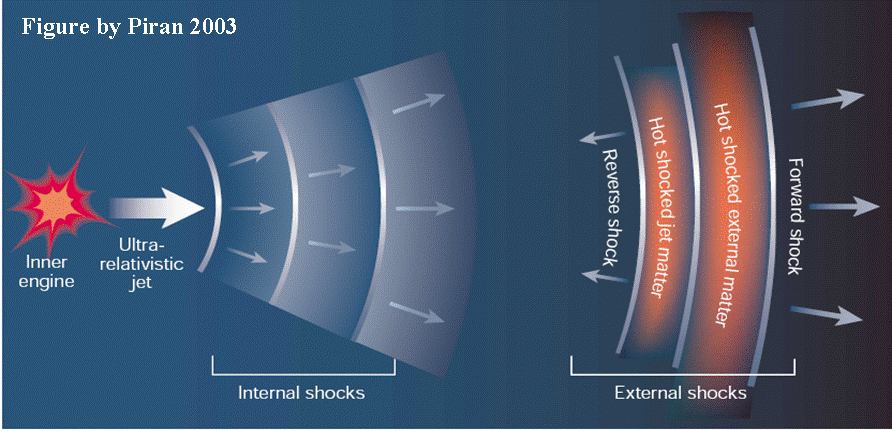 |
|
| GRBs are considered to be emission from highly relativistic jets with bulk Lorentz factor over 100, which is supported by both of observations and theories of GRBs. There are many stages for GRB explosion. At first, the central engine of GRBs is the phenomenon at the center of the progenitor (within 10^8 cm), formation and propagation of highly relativistic jet has a length scale of 10^10 cm, internal shocks, where gamma-rays are emitted, occurs at around 10^13-10^14 cm, afterglow phase, where low energy photons (lower than X-rays) are emitted, occurs at around 10^15-10^16 cm. Particle acceleration and emission of gamma-rays and neutrinos that come from decay of the high-energy cosmic rays may be possible at various stages. GRBs are filled with various mysteries at all stages from the central region to afterglow phase. We are studying such mysteries at all stages to understand the whole picture of GRBs. | |
1. Central Engine of GRBs |
|
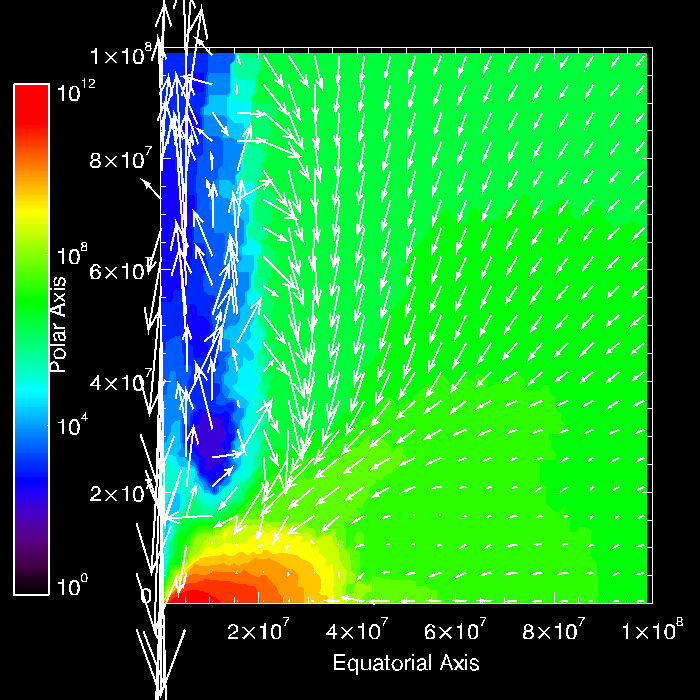 A simulation of gravitational collapse and jet formation in a rotating massive star. Jet is launched by magnetic pressure that is amplified by a rotating accretion disk around the black hole (Nagataki et al. 2007). |
Some GRBs, which are categorized as Long GRBs whose duration is larger than 2sec, are related with supernovae. Explosion energy of these supernovae is typically ten times larger than that of normal core-collapse supernovae. Thus the explosion mechanism of such supernovae cannot be explained by the standard scenario of core-collapse supernovae. That means the central engine of GRBs has to be entirely different from the one of normal core-collapse supernovae. There are some promising scenarios to explain the central engine of GRBs. One is that a rapidly rotating massive star collapses gravitationally, forming a black hole at the center and an accretion disk around the black hole, and the GRB jet is launched along the rotation axis by the thermal pressure that comes from the pair annihilation of neutrio and anti-neutrinos that are emitted from the accretion disk. Another one is that magnetic fields are amplified in the accretion disk, forming the GRB jet by megnetic pressure. Other one is rotation enegy of the black hole can be extracted through the magnetic fields around the black hole (Blandford-Znajek effect), and the GRB jet is launched by the extracted energy. Since analytic solution can not be obtained unless the system is sufficiently simplified, we adopt the approach of numerical simulations. In order to understand what happens at the center of the collapsing star, we are performing numerical simulations that solve non-linear equations of motions that include many microphysics. |
|
|
|
2. Pair Annihilation of Neutrinos around Accretion Disk |
|
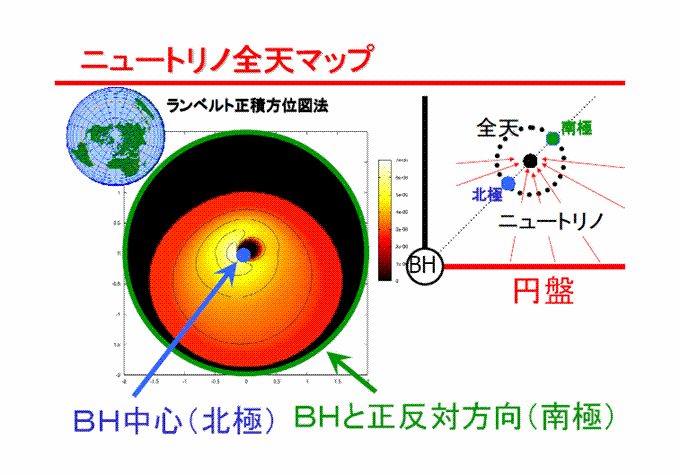 |
As explained above, there is one promising mechanism to launch a GRB jet in which emission of neutrinos from the accretion disk and pair annihilation of neutrinos play an important role. In order to evaluate this effect quantitatively, we have to take account of the bending effect for neutrinos' world lines due to general relativistic effect. In case the black hole is rotating, more neutrinos co-rotate with the black hole. In particular, within the ergo-sphere, neutrinos cannot propagate toward the opposite direction of the black hole about the rotation axis. In such a situation, the efficiency of pair annihilation of neutrinos depends on the general relativistic effects. Thus my colleague, Dr. Rohta Takahashi, solves a static accretion disk taking account of general relativistic effects. We are investigating the efficiency of pair annihilation using the solution and taking account of general relativistic bending effect. |
| Contour of intensity of neutrinos from an accretion disk around a kerr black hole. World lines of neutrinos emitted from the accretion disk bend in the Boyer-Lundquvist coordinate due to the general relativistic effects. The black hole is set at the center, observer is set at 500km away from the black hole in the direction of 45 degree in the zenith-angle (Takahashi and Nagataki 2007). | |
3. Propagation of GRB Jet |
|
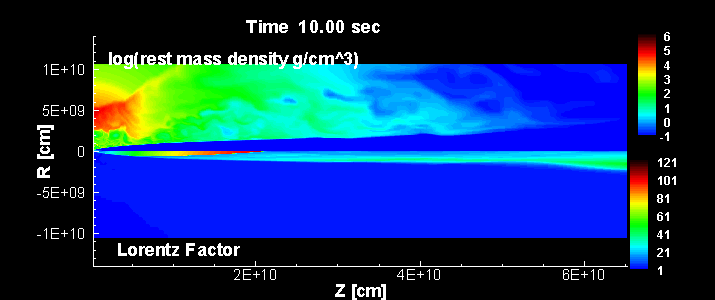 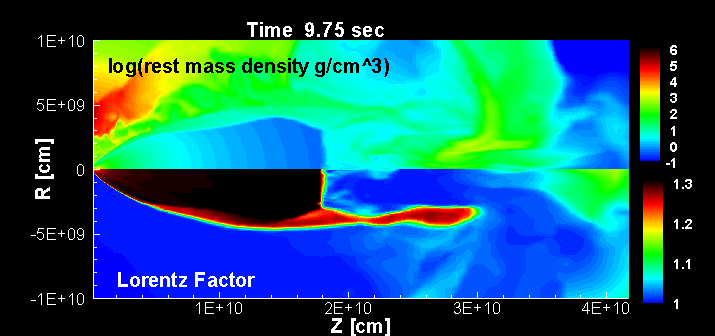 |
Even if the central engine of GRBs work so well, it is not apparent
how the jet penetrate the progenitor and how the jet produces internal
shocks. In particular, from an observational constraint, the bulk
Lorentz factor of the jet at the internal shock phase has to be
as high as several hundreds. This constraint means that the rest mass of
the jet has to be around 10^-6 Msolar. We do not at all how such a "light"
jet is formed at the center of the "massive" progenitors.
I am studying with Dr. Akira Mizuta how such a jet is formed and propagates
by numerical simulations with super-computers.
Upper panel: Propagation of a jet with high bulk Lorentz factor. When kinetic energy is mainly injected at the center of the star, the bulk Lorentz factor of the jet becomes as high as 100. Lower panel: Expanding outflow. When thermal energy is mainly injected at the center, a jet is not formed but expanding outflow is realized, which can not be a GRB (Mizuta et al. 2006). |
|
|
|
4. Particle Acceleration in GRBs |
|
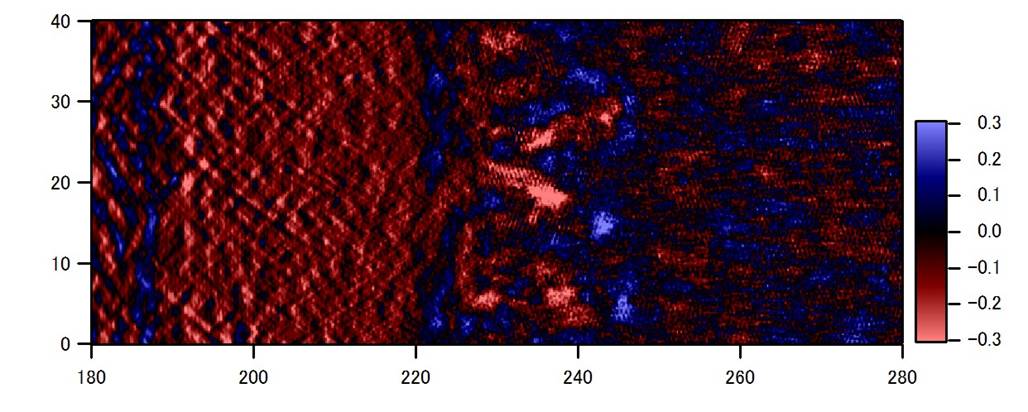 Simulation for the formation of relativistic shock with magnetic fields in the up-stream. Colors show the number density of charged particles. We can see that instabilities are glowing in the down-stream. From phenominological discussion, it is required that magnetic fields have to be amplified so much in GRBs, which can not be achieved by magneto-hydrodynamic approximation. Thus effects of magnification of magnetic fields due to plasma instabilities are considered to be very important in GRBs. |
Emission mechanism of GRBs are usually considered to be synchrotron radiation from non-thermal electrons. At least, since the spectra of GRBs are far from thermal one, it is clear that non-thermal charged particles are generated in GRBs. However, we do not know how such non-thermal particles are generated. The most promising mechanism is the first-order Fermi acceleration in the internal shocks. But it is not apparent how such internal shocks are formed. This is because we have to consider the formation of relativistic, collision less shocks, in which charged particles do not collide with each other, but a shock has to be formed. Recently, Particle in Cell (PIC) method is bringing a great progress in the field of formation of relativistic, collision less shocks. In this method, equations of motions for charged particles and Maxwell equations for electro-magnetic fields aroud the charged particles are solved at the same time numerically. I am studying this topic with Dr. Tsunehiko Kato, Osaka University using PIC method to understand the formation of collision less shocks in GRBs. |
|
|
|
5. High Energy Gamma-rays and Neutrinos from GRBs |
|
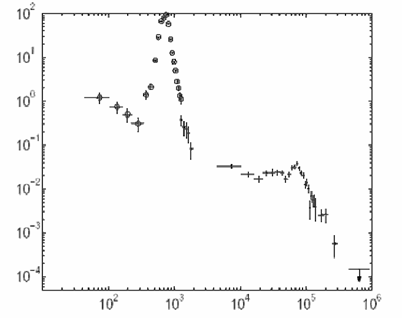 |
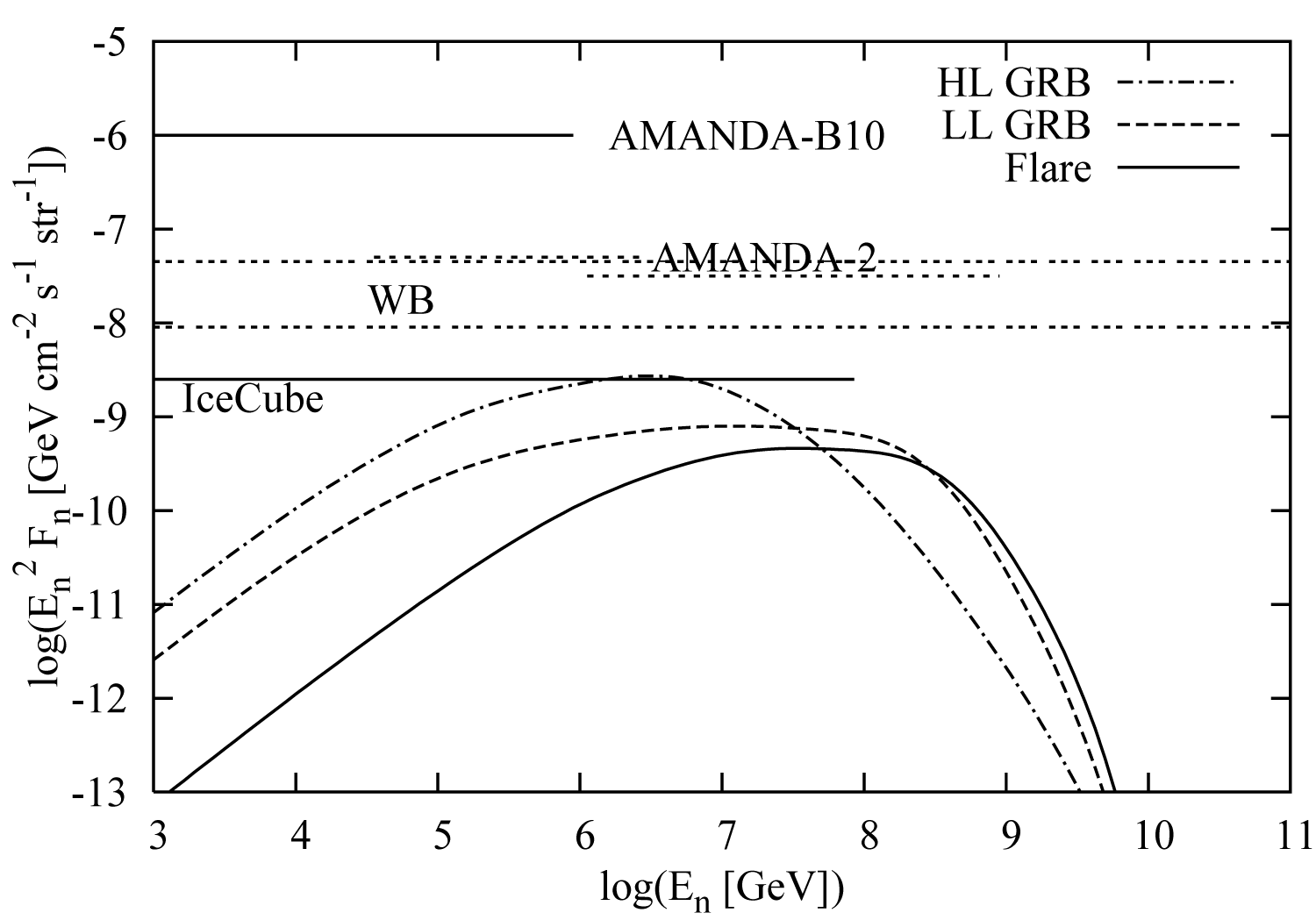 |
|
|
|
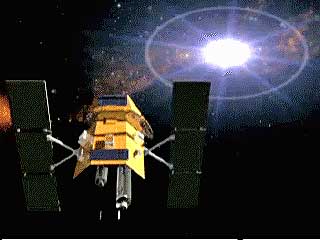 |
Emission mechanism of GRBs is considered to be synchrotron radiation from electrons. If so, protons should also be accelerated, and there is a possibility that we can detect signals from such non-thermal protons. For example, such accelerated protons can interact with photons in GRBs, produsing neutral and charged pions. We may be able to detect high energy gamma-rays and neutrinos, which are decay products of the pions with GLAST and IceCube. I am studying the flux of high energy gamma-rays and neutrinos from GRBs with my student, Kohta Murase. In particular, since the newest GRB satellite, Swift, is providing us with some new phenomena in GRBs, we are considering whether high energy signals can bring some informations to understand such new phenomena. |
| Upper left panel: X-ray flare in the early afterglow phase, reported by Swift. Upper right panel: Flux of high energy neutrinos correlated with such flare. Flux of neutrinos from internal shocks is also shown for comparison (Murase and Nagataki 2006). Lower panel: Image of Swift (from NASA Home Page). | |
6. Propagation of UHECRs |
|
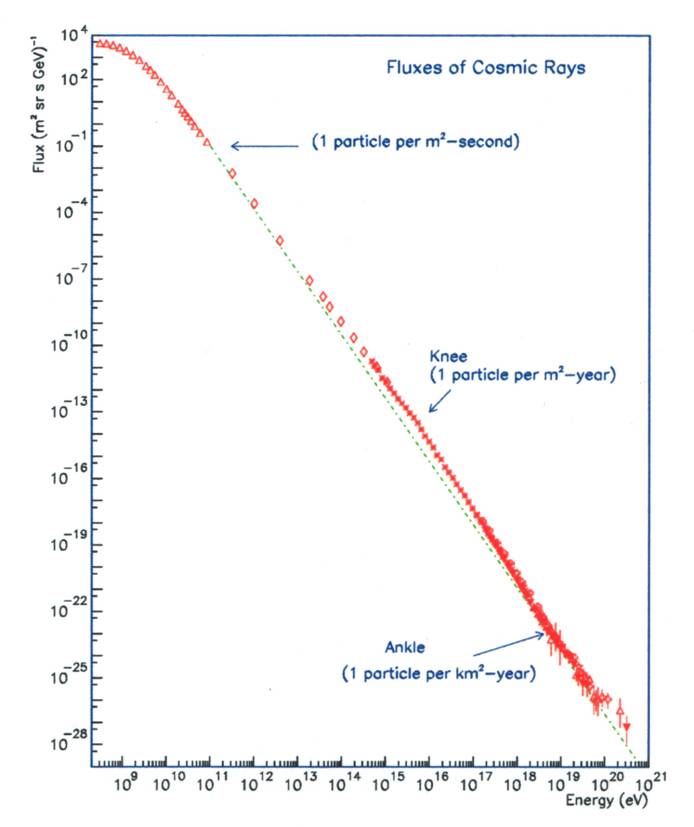 |
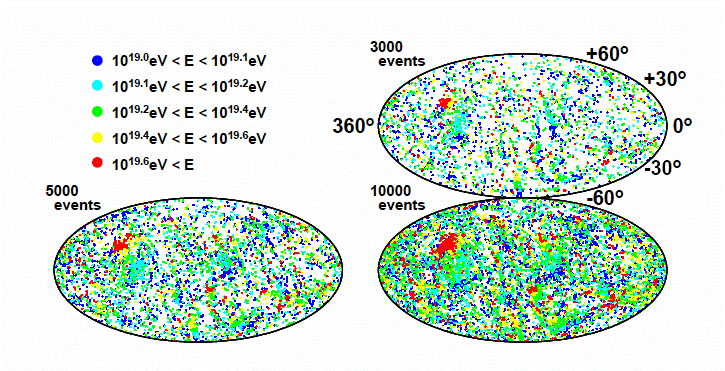 A simulation of UHECRs (Yoshiguchi, Nagataki, Sato ApJ 596 1044 (2003))ĄŁ When many UHECRs are detected by Auger, small angle clustering like upper panel will be seen. Left panel: energy spectrum of CRs at the earth. Low energy component (lower than 10^15eV) will be from supernovae in our galaxy. Origin of high energy component is not known well. |
| While part of non-thermal protons produced in GRBs interacts with photons in GRBs, producing high energy gamma-rays and neutrinos, the rest of them should escape from GRBs and propagate in the universe. GRBs have a potential to accelerate protons upto UHECRs, so the observed UHECRs at the earth may come from GRBs. We are studying this topic, and whether the origin of the observed UHECRs is GRBs or other astronomical objects (including top-down scenarios such as decays of long-lived, super-heavy particles). | |
7. Explosive Nucleosynthesis in GRBs and Supernovae |
|
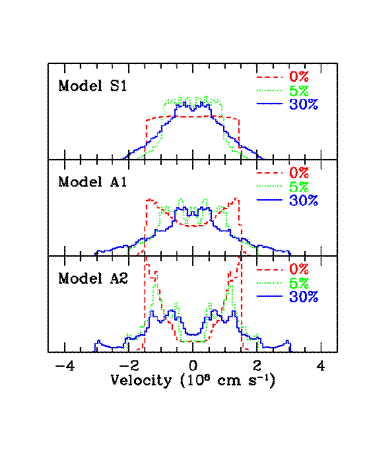 |
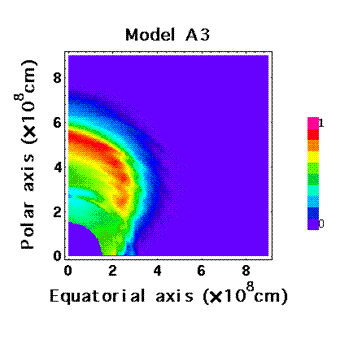 Left panel: Velosity distribution of Fe in a supernova ejecta for various aspherical explosions. From above, spherical explosion, mildly aspherical explosion (ratio of escaping velocity of ejecta around polar region against around equatorial plane is set to be 2:1), aspherical explosion (ratio is set to be 4:1). Line profile of Fe in SN 1987A is similar to the mildly aspherical explosion model. Line profile of Fe from a supernova associated with a GRB has shown the splitted feature, like aspherical explosion model, which shows highly aspherical explosion (like jet-induced explosion) occured in the supernova. Right panel: Contour of mass fraction of 56Ni in a highly asperical explosion (ratio is set to be 8:1). In such a highly aspherical explosion, much 56Ni is synthesized in a jet region (around the polar axis) because temperature becomes high around there. |
| Jet-like explosion can occur in even normal core-collapse supernovae when effects of rotation are taken into account. Recently, from the observations of polarization, it is well said that supernova remnants are not spherically symmetric, but oblate ones. We considered that there should be traces of jet-like explosion in the products of explosive nucleosynthesis. Thus we performed numerical simulations for that and compared the results with the observations of SN1987A (Nagataki et al. 1997; Nagataki 2000). As a result, we found that line profiles of iron in SN1987A and luminosity of SN1987A at late phase, which is powered by decays of 44Ti, can be explained best by mildly aspherical explosion model. Recently, we adopt our approach to the explosive nucleosynthesis in supernovae that are associated with GRBs. In particular, we are interested in the origin of 56Ni that powers the luminosity of the supernovae very high (Nagataki et al. 2003; Nagataki et al. 2006). | |
8. High Energy Gamma-rays and Neutrinos from Neutron Stars |
|
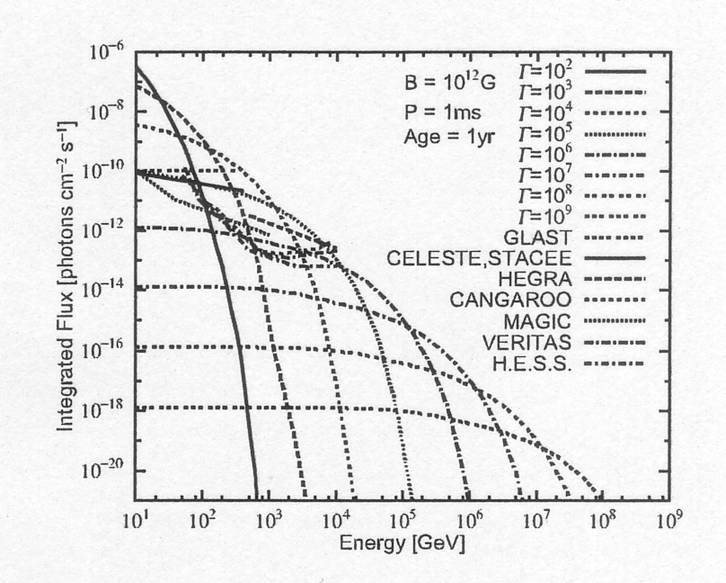 |
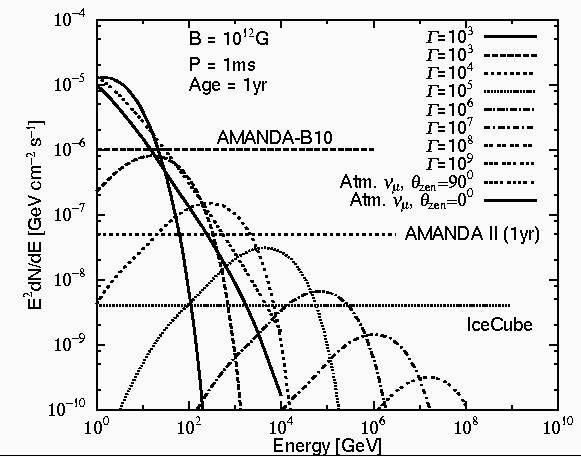 |
|
|
|
 |
Neutron stars with magnetic fields produce electric fields by rotation, so charged particles are accelerated directly through such electric fields. The accelerated particles are considered to be dominated by electron-positron pairs. However, it is pointed out that protons and/or irons can be also extracted from the surface of the neutron stars. These baryons are accelerated like electron-positron pairs, interact with surrounding supernova remnants generating neutral and/or charged pions, which result in high energy gamma-rays and neutrinos. We have estimated flux of high-energy gamma-rays ane neutrinos at the earth when a supernova explosion occurs in our galaxy, and discussed whether these signals can be detected by gamma-ray detectors such as GLASR, HESS, CANGAROO and neutrino detectors such as IceCube (Nagataki 2004). The central engine of GRBs may be a rotating neutron star with strong magnetic fields. In that case, similar mecanism may work at the center of GRBs. |
| Upper left panel: Flux of gamma-rays from a neutron star surrounded by a supernova remnant in our galaxy. Upper right panel: Flux of neutrinos from such an object. Lower panel: Crab nebula (from NASA home page). | |